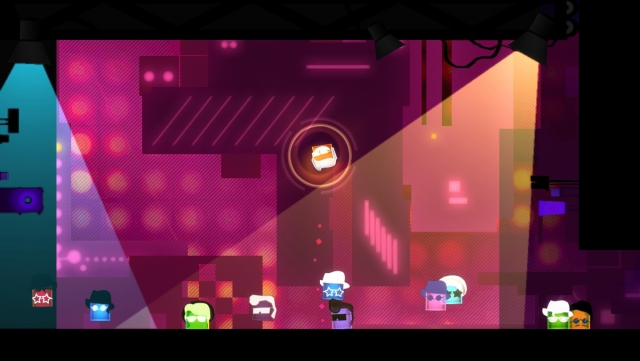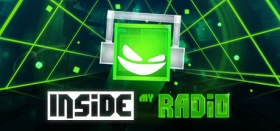
Inside My Radio Review
If there’s anybody in the world that find music clubs fun, what I got from playing Inside My Radio must be something similar to what they experience then. I’m not an old fuddy-duddy, on the contrary, I love good music and dancing to it, and flashy lights, bright colours and a gloomy atmosphere don’t sound bad at all. It’s probably the combination of all this with mediocre music and sweaty people that keeps me away from hitting the dance floor nightly. Luckily, one of my better options is Inside My Radio. Certainly Inside My Radio has a great deal of awkwardness at points — just like me in clubs —, but as frustrating as it can be occasionally, it always kept me dancing to the bopping, hypnotic and mesmerizing music. And luckily, there was no awkward small-talk required.
Inside My Radio is an indie platform side-scroller where you take the role of three shiny squares — Taek, Barry and Root. They are stereotypical night-goers, all of them assuming different music-defined roles. Taek is dragged into the radio — where all the action happens — to help some sort of higher entity free Barry and Root, and fight what kidnapped them and corrupted the whole device. Taek is green, always wears big headphones and is into techno music, so as you’d expect, this is the music that plays while you control him. Barry is the cheeky ‘70s funky-sort-of-type, bright orange, wears a toupee and white shiny sunglasses… to a club. He rocks the dance floor and beats up thugs; as if taken straight from Saturday Night Fever. Lastly, there’s Root. He’s a purple scatterbrained, stoner-looking square with a thing going on for reggae music. The mechanics barely change when playing from one to another; rather, the platforming sections work differently depending on your character, you may have bouncy bits as Barry, but as Root, you may find switches to modify the environment as you please.
 The control system is tied to the throb of the music no matter what kind of music is playing. We recently covered Crypt of the Necrodancer, a game with a very similar premise. In this game, for every move or action you take, it must be done in-time with the music. For every beat, you must press the button at the same moment. The result is you constantly embodying the music through the mechanics. It is impossible to disconnect one from the other, as there’s nothing you can do without the beat. The way music is so intrinsically involved in the mechanics of Crypt of the Necrodancer is, in a nutshell, the reason why it’s been praised so much. Inside My Radio starts off presenting itself with the same idea for the basic mechanics. However, music and controls don’t merge as well as it was probably intended to be.
The control system is tied to the throb of the music no matter what kind of music is playing. We recently covered Crypt of the Necrodancer, a game with a very similar premise. In this game, for every move or action you take, it must be done in-time with the music. For every beat, you must press the button at the same moment. The result is you constantly embodying the music through the mechanics. It is impossible to disconnect one from the other, as there’s nothing you can do without the beat. The way music is so intrinsically involved in the mechanics of Crypt of the Necrodancer is, in a nutshell, the reason why it’s been praised so much. Inside My Radio starts off presenting itself with the same idea for the basic mechanics. However, music and controls don’t merge as well as it was probably intended to be.
As the shiny little squares you incarnate, you can jump, dash, body-slam and dance. These four actions and their resultant combinations are the only actions bound to the rhythm. This doesn’t sound bad at all; the problem appears when the movement mechanics come into play. Your characters’ travel speed and cadence are completely generic, substantially resembling any other platform-based side-scroller. If the game didn’t have pretensions of orbiting so much around the music, I would give this a pass, but the lack of cohesiveness between movement and the four actions above is simply too disorienting. First off, you will spend most of the time moving horizontally, but because the music is irrelevant to that motion, it never feels right having to coordinate your occasional jumps or dashes with the music. On top of that, falling after a jump or dropping off from a ledge is not held to the beats of the music either, which means that the moments you’re doing so are equally alienated from the points where you’re combining dashes, wall-jumps and slams.
 I believe this problem stems from the level design and the required approach to it. The puzzles, or the sections where a combination of dashes and jumps are required, are too spread out from each other, so it never feels like there’s any continuity in moving following the music. You’ll do it for five seconds, but you’ll spend the next twenty simply sliding to the right, with an occasional jump that barely needs any sense of rhythm. Even the final boss can be easily beaten with the game muted, as you don’t need to jump or dash at all! If the left stick had been totally dropped and they’d chosen dashes as the main way of travelling, this game would have worked much better! It would have been very similar to Crypt of the Necrodancer, but it wouldn’t have suffered that lack of cohesiveness.
I believe this problem stems from the level design and the required approach to it. The puzzles, or the sections where a combination of dashes and jumps are required, are too spread out from each other, so it never feels like there’s any continuity in moving following the music. You’ll do it for five seconds, but you’ll spend the next twenty simply sliding to the right, with an occasional jump that barely needs any sense of rhythm. Even the final boss can be easily beaten with the game muted, as you don’t need to jump or dash at all! If the left stick had been totally dropped and they’d chosen dashes as the main way of travelling, this game would have worked much better! It would have been very similar to Crypt of the Necrodancer, but it wouldn’t have suffered that lack of cohesiveness.
If there’s something to love about the level design is how vibrant and alive they feel. Scattered through the scenery there are speakers, lamps, trees and other less recognizable objects that dance to the beat of the music. They really give the sensation that the music and the level are a whole, boogying in the background as you prance your way through the level. The platforms also move and blink following the pulse of the music, which in turn, due to the lack of consistent mechanics, furthers the feeling that the level and music are divorced from your actions. The lively atmosphere with vivid lights and colours is accompanied by the playful and light-hearted characters, always busting moves in the background as you progress. Again, all this happens inside a radio, which makes sense with the theme of electricity that can be found in each level.
 Sadly, the exposition in this game is nothing short of obtuse. The narrative is not particularly complex: Taek, after being drawn in by some sort of god-like entity into the radio, is tasked to save Barry and Root, and then, with their aid, liberate it from the creature that’s laying waste inside it. The conversations among these four characters are poorly and clumsily written, which, alongside the simplistic story, doesn’t really get you invested in the plot. However, the most reprehensible aspect is the font they chose for the dialogues. It sounds stupid, I know, but I really struggled making sense of some words because of how unintelligible it is. There still are some parts where I didn’t know what they were saying!
Sadly, the exposition in this game is nothing short of obtuse. The narrative is not particularly complex: Taek, after being drawn in by some sort of god-like entity into the radio, is tasked to save Barry and Root, and then, with their aid, liberate it from the creature that’s laying waste inside it. The conversations among these four characters are poorly and clumsily written, which, alongside the simplistic story, doesn’t really get you invested in the plot. However, the most reprehensible aspect is the font they chose for the dialogues. It sounds stupid, I know, but I really struggled making sense of some words because of how unintelligible it is. There still are some parts where I didn’t know what they were saying!
Admittedly, there are a few satisfying puzzles, but they’re designed for dummies. The boss battles are ultimately long simplistic music-based puzzles that you just have to push through. And regarding the final boss, fighting it three times may sound a bit repetitive, but because its patterns change every time, it stresses out its toughness above anything — excluding the final bit, that literally can be played without being able to hear the music. What’s more, this boss is the only time where you are actually punished for dying — yeah, we get it, the boss is a toughie. Needless to say, they all carry the same flashy visuals matching so well with such bopping music.
 Indeed, the visual style and particularly the music are the most appealing points of the game. The music adapts and reacts to the level and changes style depending on the character, although keeping the same beat, simplifying things for those without much sense of sense of rhythm. I certainly couldn’t stop tapping my foot with the music. I’m still not going to clubs though.
Indeed, the visual style and particularly the music are the most appealing points of the game. The music adapts and reacts to the level and changes style depending on the character, although keeping the same beat, simplifying things for those without much sense of sense of rhythm. I certainly couldn’t stop tapping my foot with the music. I’m still not going to clubs though.
Inside My Radio (Reviewed on Windows)
The game is average, with an even mix of positives and negatives.
Excellent visuals, music, and sound. Sadly, the inconsistency in its mechanics makes playing feel very discontinuous, where the music never fully gets hold of the player.









COMMENTS